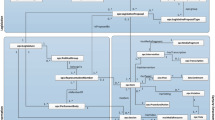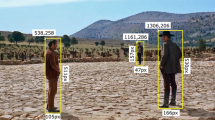Abstract
Due to the high complexity and exponential growth of videos, video data management tasks, such as understanding and annotating semantic content, are very difficult to be accomplished. Dance videos are one such critical domain. Considering the various dance components, understanding their semantic content conceptually, extracting the expressive semantics, annotating them properly and storing the annotations in a suitable medium for future reuse and analysis, are the essential tasks for the next generation dance systems. This paper presents a conceptual multimedia data model based on Protocol Analysis, called Video Semantics Directed Acyclic Graph (VSDAG) model. The expressive semantic content, represented by VSDAG model, is extracted from the video by a unique video annotation system. The generated annotations are stored in a XML compliant structure.
Access this chapter
Tax calculation will be finalised at checkout
Purchases are for personal use only
Preview
Unable to display preview. Download preview PDF.
Similar content being viewed by others

References
Dorai, C.: Computational Media Aesthetics: Finding meaning beautiful. IEEE Multimedia, 10–12 (October-December 2001)
Shneiderman, B.: Meeting Human Needs with new digital imaging technologies. IEEE Multi Media 9(4), 8–14 (2002)
Davcev, D., Trajkovic, V.: OO modeling of spatio-temporal dance data. ACM-ITP, 76–81 (2002)
Saraswathy, K.: Bharatha Nattiya Kalai, Thirumagal Nilayam (1994)
A web of Indian classical dances, http://www.narthaki.com/index.html
Hutchinson, A.: Labanotation: The system for recording movement, T Art Books (1954)
Ann Hutchinson, G.: Dance Notation: process of recording movement Dance Books (1984)
Chen, L., Ozsu, M.Tamer: Modeling video data for content based queries: Extending DISIMA image data model. Multimedia Modeling, 169–189 (2003)
Day, Y.F., Khokhar, A., Ghafoor, A.: A framework for semantic modeling of video data for content based indexing and retrieval. ACM Springer Multimedia Systems J 7(5), 409–423 (1999)
Chen, S.C., Shyu, M.-L., Kashyap, R.L.: ATN as a semantic model for video data. Int., J. of NIS 3(1), 9–25 (2000)
Day, Y.F., et al.: OO conceptual modeling of video data. IEEE conf Data Engg., 401–408 (1995)
Chen, L., Ozsu, M.T.: Modeling of video objects in a video database. In: IEEE Conf. ICME, pp. 217–221 (2002)
Hacid, M.S., Decleir, C., Kouloumdjian, J.: A database approach for modeling and querying video data. IEEE Trans. on Knowledge and Data Engineering 12(5), 729–750 (2000)
Arun, H., Ramesh, J., Terry, E.: Production Model Based Digital Video Segmentation. Furht, pp. 111–153 (1996)
Arie, B., et al.: Human Activity Recognition using Multi dimensional indexing. IEEE Trans. on Pattern Analysis and Machine Intelligence 8, 1091–1104 (2002)
Stephane, et al.: Face tracking and realistic animations for Telecommunicant clones. IEEE Multi Media, 234–242 (2000)
Gong, Y., Sin, L.T., Chuan, C.H., Zhang, H., Akauchi, M.: Automatic Parsing of TV Soccer Programs. IEEE Conf. MM Comp. & Sys., 167–174 (1995)
Campbell, L.: Recognizing Classical Ballet Steps Using Phase SpaceConstraints. MIT Media Lab TR297, http://www-white.media.mit.edu/cgi-bin/tr_pagemaker
Ericsson, et al.: Protocol Analysis:Verbal Reports as Data. The MIT Press, Cambridge
Gaborski, R.S., Vaingankar, V.S., Chaoj, V.S., Teradesai, A.M.: VENUS: A system for novelty detection in video streams with learning. In: Proc. 17th Intl. conf. FLAIRS, South Beach, FL (2004), PaperID #154
Author information
Authors and Affiliations
Editor information
Editors and Affiliations
Rights and permissions
Copyright information
© 2004 Springer-Verlag Berlin Heidelberg
About this paper
Cite this paper
Rajkumar, K., Ramadoss, B., Ilango, K. (2004). An Approach for Conceptual Modeling and Extracting Expressive Semantics from Dance Videos. In: Das, G., Gulati, V.P. (eds) Intelligent Information Technology. CIT 2004. Lecture Notes in Computer Science, vol 3356. Springer, Berlin, Heidelberg. https://doi.org/10.1007/978-3-540-30561-3_1
Download citation
DOI: https://doi.org/10.1007/978-3-540-30561-3_1
Publisher Name: Springer, Berlin, Heidelberg
Print ISBN: 978-3-540-24126-3
Online ISBN: 978-3-540-30561-3
eBook Packages: Computer ScienceComputer Science (R0)



